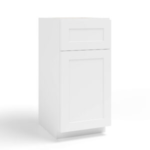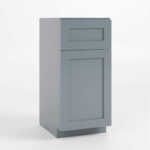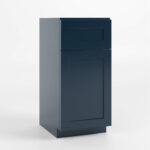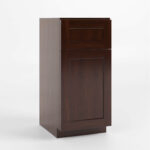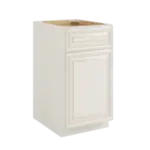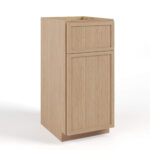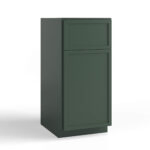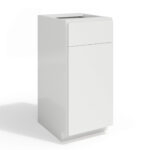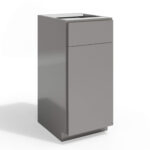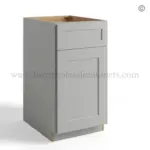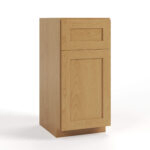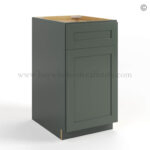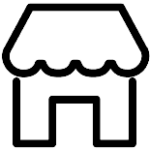Table of Contents
When you consider remodeling your house, the kitchen is the first thing that comes to mind. As the heart of your home, the types of base cabinets you choose will define the kitchen’s beauty, utility, and aesthetics alongside wall cabinets.
Base cabinets don’t just provide storage space for sheltering your pots, pans, crockery, or groceries. They improve your kitchen’s overall appearance and functionality and seamlessly organize and accommodate the appliances, support countertops, and sinks. These versatile cabinetry options are available in numerous varieties, configurations, and sizes, allowing homemakers to explore options and select the best for a successful kitchen project.
In this blog, we will explore everything you need to know about the different types of base cabinets, their features, and tips for choosing the right one.
What Is a Base Cabinet?
A base cabinet is a box or a case installed on the floor to hold up counters and kitchen surfaces. Generally installed under the countertop, these cabinets often come with drawers, shelves, and doors to allow users to store items in an organized manner. From cleaning supplies to pantry items, you can use these cabinets to store goods or as the foundation for sinks, dishwashers, or other appliances. Proper installation and regular maintenance are necessary to enhance stability and functionality and maintain the product’s structural integrity for prolonged performance.
But are cabinets actually functional?
Absolutely! Here’s why:
- Clean and Organized Area: Kitchen cabinets provide additional storage and allow easy categorization, meaning everything, from cookware to toiletries, will be clutter-free and elegantly organized as you would like.
- Easy Access: Traditional cabinetry selection required one to bend over or stoop to retrieve items from the back, which was challenging for individuals with back issues. However, modern cabinets have pull-out drawers for quick and easy access to items kept far back.
- Improved Ergonomics: Base kitchen and restroom cabinets with drawers are designed to extract things easily without straining one’s back, neck, or knees. Designed with soft-close mechanisms, cabinet doors and drawers open and close easily, ensuring smooth and seamless operation, especially in high-traffic areas.
- Enhanced Aesthetics: Cabinets create new possibilities around the house. Open cabinets with shelving can store books, extra pantry items, cookware, and more. In addition to storing items, lower-profile drawer cabinets create a window seat in any room, elevating the decor.
Key Features of Base Cabinets
If you are interested in remodeling or decorating your kitchen, you will come across many options that combine aesthetics and functionality. Whether you opt for classic designs or prefer the contemporary touch, it’s imperative that you understand the nuances of a base cabinet.
Support Structure
As the name suggests, a base cabinet is installed on the ground and supports the top of the counter, while wall cabinets are hung on the wall. These are typically 24” deep and vary by width. Here are the key components of a base cabinet:
- Cabinet Carcass – The entire cabinet box.
- Concealed Hinge – Found attached to the inside of the door
- Drawer Face – The front piece of the drawer box where the handle is attached.
- Drawer Box – The box of the drawer, excluding the front face.
- Face Frame – Attached to the front edges of the cabinet box, the frame adds strength to the box.
- Frameless Cabinet – A cabinet without a frame on the front edge that exposes the box’s sides, top, and bottom, with the height and full width of the door covering the cabinet box to the edges.
- Full-Inset Cabinet – The door fits inside the frame when closed in these cabinets.
- Full Overlay – The door or drawer covers the entire frame; only the door is visible, not the other parts of the frame.
- Partial Overlay – The cabinet doors or drawers partially overlap the frame, and parts of the frame remain visible.
- Toe Kick – The cutout of a cabinet’s bottom (typically 3.5 to 4 inches high) that provides room for feet when standing near the cabinet.
Material Options
Various materials are used to make cabinets, from hardwood to medium-density fiberboard (MDF).
- Hardwood – Most durable option, includes cherry, oak, maple, alder, and lyptus.
- Plywood – Medium and softer woods glued together for cabinet construction.
- MDF – Fine wood fibers and glue fused with heat and pressure; doesn’t expand or contract
- Particle Board – Sawdust and glue fused with heat and pressure, a less durable option.
- Wood Veneer – Thin sheets of real wood glued to a substrate like medium-density fiberboard; an affordable option.
- Melamine – Thin plastic sheets fused to substrate; scratch and stain-resistant.
- Metal – Stainless steel or aluminum for strength and durability
- Thermofoil – A thin layer of vinyl vacuum-pressed onto the cabinet drawers and door front, typically constructed from MDF.
Construction Style
You will find a wide variety of kitchen cabinets, but all come down to the two basic types:
- Frame cabinets are the most popular type of cabinets constructed by attaching a framework of solid lumber to the front. Mounted in three different ways: inset, overlay, or lipped, framed cabinets are preferred because of their classic look and easy accessibility.
- Frameless cabinets define simplicity, significantly reduce material and production time, and boost efficiency. The drawers are wider and deeper, ensuring quick cleaning.
Different door styles are designed for specific cabinet themes. The popular ones being:
- The Shaker Style – Offers a clean look with plain lines, a recessed panel, and minimal ornamentation
- Slab Cabinet – The flat-panel style gives a clean, minimalist look without ornamentation.
- Raised Panel – Raised panels feature a center raised panel, typically found in traditional kitchens and dated homes.
- Beadboard Style – Beadboard features vertical peeling and adds texture to various kitchen designs.
- Louvered Style – Made from horizontal wood slats, this style provides ventilation to keep the items stored inside fresh, especially in areas with high humidity and mold issues.
- Glass Front Style – A combination of glass and solid cabinets showcases your glassware and gives your kitchen a beautiful touch.
Height & Depth
Although base kitchen and bathroom cabinets come in various styles and sizes, the standard sizes are:
- Height: 34.5 inches
- Depth: 24 inches
- Full Width: Between 9 and 48 inches
- Door Height: 30 inches
- Kitchen Bottom Cabinet Height: 35 inches (varies between 33 and 39 inches)
- Countertop Height: 1 to 1.5 inches
- Kickboard Height: 4.5 inches
Customization Options
You will find cabinets in various heights and depths to match your kitchen decor and home aesthetics. From pull-out trays to blind corner solutions and Lazy Susans, endless design options are available. You can choose the material, panel style, finishes, features, and size options based on your kitchen area and budget and reconfigure the sections to accommodate new items without investing in extensive remodeling work. However, customized cabinets with modular designs tend to be costlier than typical designs because they are made to your specifications to give your home a unique touch.
Finish & Aesthetics
The finish of the cabinets plays a pivotal role in defining the overall look. The popular cabinet finishes include:
- Stained – Highlights the grains to enhance the natural appearance of the wood. Stains come in different shades, from dark to light, to give a traditional to rustic and sophisticated look.
- Glazed – A semi-transparent coating is applied over the stain or paint to give the cabinet an antique look, add depth, and improve the aesthetics of classic kitchens.
- Painted – While painting white, black, navy, or gray cabinets gives farmhouse-style kitchens a smooth, uniform look, it often leads to chipping.
- Distressed – Often used in rustic and shabby-chic kitchens, the distressed finish involves sanding and treating the surface to create an aged or worn-out look.
- Natural Finish – If you want to showcase the natural beauty of your wooden cabinet, the natural finish gives it the perfect touch while reducing moisture and preventing wear.
Today, modern kitchen cabinet designs emphasize blending aesthetics with utility. They create clean, clutter-free areas with smooth, cohesive looks. Traditional handles and knobs are replaced by sensory mechanisms to contribute to the sleek appearance and ensure a user-friendly experience. Furthermore, the flat surfaces of the cabinet are well-lit with built-in lighting, simplifying cleaning and maintenance.
However, modern cabinets are not restricted to minimalist aesthetics. You can experiment with bold colors, contrasting elements, and contemporary cabinet hardware to create a visually captivating space that complements your personality and reflects your style and taste.
Installation Base
Installing a base cabinet requires a recessed toe kick for better foot clearance, improved stability, and a solid platform base to support the cabinet’s weight. Depending on the design, cabinets are installed directly on the floor on adjustable legs or a built-in frame. Proper leveling using leg adjusters or shims is necessary to ensure accurate alignment. Most importantly, cabinets are secured to wall studs for stability and safety, and the base may include cutouts at the back for electrical access or plumbing work.
Types of Base Cabinets
Decoding the intricacies of cabinet construction can be tedious when there are numerous cabinet options. To help you decide, we have elaborated on the key considerations of four popular cabinet ideas.
Standard Base Cabinets
Widely preferred in U-shaped and L-shaped layouts, a standard base cabinet is kept directly on the floor and serves as the kitchen’s workspace and countertop base. Typically, these cabinets are 34.5 inches tall without the countertop and approximately 24 inches deep, with widths ranging from 12 to 48 inches. The configurations generally include drawers, doors, pull-outs, and combinations.
While these cabinets are sturdy, heavy lifters, and highly versatile, they occupy a significant space, limiting movement and resulting in hard-to-reach corners.
Sink Base Cabinets
A sink base cabinet supports a kitchen sink. It typically features two false-front drawers and two large doors at the bottom to provide access to plumbing work. Wider sink cabinets, like 36 and 42 inches, are more popular for open-concept kitchen designs. The larger size gives extra room for storing additional items, meeting functional and style requirements. The thoughtful spacing, ergonomic handles, and lowered height prioritize inclusivity and convenience.
Even though standard sizes are easy to install and highly compatible, custom sizes require precision measurements and higher charges.
Corner Base Cabinets
A corner base cabinet is ideal for fruitfully utilizing one of those tricky corner spots. These cabinets are synonymous with sturdiness and durability and are easy to assemble. Usually featuring one false-front drawer and two doors, they ensure easy accessibility to the stored items regardless of the angle. Corner cabinets come in many sizes, the standard being 33”, 36”, and 39”, and can be hinged on either side.
Although larger cabinets have wider openings, which improves accessibility to smaller items inside, finding what you need can be difficult in smaller models without pull-out shelves. The awkward dimensions often result in wasted room and are more challenging to install.
Drawer Base Cabinets
A drawer base cabinet is a versatile option for organizing your kitchen or other rooms in your home. Its ergonomic design provides easy access to the stored items and seamlessly integrates with the surrounding decor, creating a cohesive look. The standard configuration generally ranges from 12” to 36” in width, 29.5” in height, and 24” in depth. Some of the latest models also come with built-in power solutions for device charging, making it a valuable modern kitchen unit that interacts with technology.
Despite the benefits, these cabinets have major drawbacks, such as limited vertical storage capacity, higher costs, and potential damage due to the frequent opening and closing of drawers.
How to Choose the Right Base Cabinet for Your Kitchen
Finding the right cabinet primarily depends on your budget, kitchen layout, style, aesthetic preferences, and functional needs. Your focus should be on balancing visual appeal with durability and storage efficiency. So, remember the following when selecting cabinets for your home.
- Consider the kitchen layout and explore which cabinets will fit the look and feel of the area.
- Think about the items you will store in the cabinets. For example, heavier items like pots and dishes need sturdy and spacious shelves.
- Customized cabinets can cost you a lot of money. Plan your budget, focusing on functionality and minimal customization.
- Decide on the finishes and frame types, whether you want a cabinet with classic frames and a stained finish or a weathered look for a rustic feel. Whatever it is, pick something that matches your style preferences.
- Finally, check the dimensions, depth, height, and width. If you customize, ensure the measurements are accurate, match your kitchen layout, and ensure accessibility.
If you are confused about which style is “the one” for your home, consult BWC Kitchen & Bath for personalized assistance. Known for crafting exceptional cabinets with precision and care, we use state-of-the-art facilities that suit individual tastes. Whether you need a kitchen cabinet with drawers or a corner cabinet to make the most of your corners, at BWC, you are guaranteed uncompromising quality, outstanding monetary value, and convenient shopping. Connect with us to experience the difference.
FAQs
What is the standard size of a kitchen base cabinet?
A base cabinet’s standard dimensions are:
- Height: 34.5” (36” with countertop)
- Depth: 21 to 24”
- Width: 12” to 42”
Can base cabinets be used in bathrooms or laundry rooms?
Yes, these cabinets are suitable for use in both bathrooms and laundry rooms to keep items organized. In addition to being used as a vanity, a base cabinet in the restroom and laundry room is perfect for storing toiletries, cleaning supplies, detergents, laundry baskets, and other washing supplies.
Are custom base cabinets worth the investment?
Yes, they are. Made with high-quality materials, customized cabinets are less likely to crack or wear out. Each design is created according to the specific dimensions of the area, so there’s no chance of awkward gaps or unused nooks. Since you select the material and finish choices, you will get a cabinet that reflects your unique taste and preferences.
